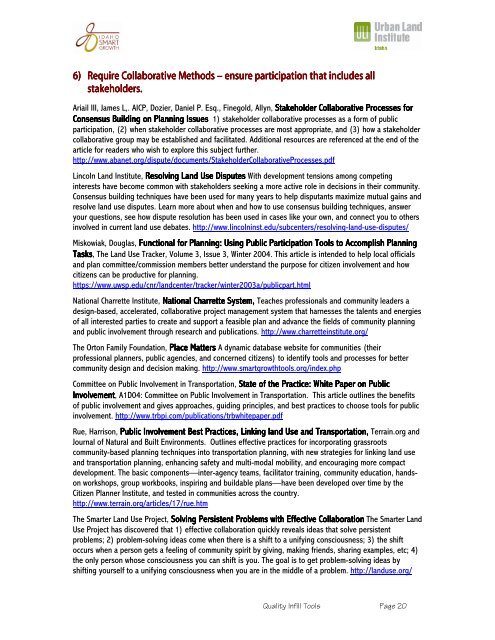Quality Infill Quality Infill - Idaho Smart Growth
Quality Infill Quality Infill - Idaho Smart Growth
Quality Infill Quality Infill - Idaho Smart Growth
Create successful ePaper yourself
Turn your PDF publications into a flip-book with our unique Google optimized e-Paper software.
6) ) Require CCollaborative<br />
C<br />
ollaborative Methods Methods – ensure participation that includes all<br />
stakeholders<br />
stakeholders.<br />
stakeholders<br />
Ariail III, James L,. AICP, Dozier, Daniel P. Esq., Finegold, Allyn, Stakeholder Stakeholder Stakeholder Collaborative Processes for<br />
Consensus Consensus Building Building on on Planning Planning Issues Issues 1) stakeholder collaborative processes as a form of public<br />
participation, (2) when stakeholder collaborative processes are most appropriate, and (3) how a stakeholder<br />
collaborative group may be established and facilitated. Additional resources are referenced at the end of the<br />
article for readers who wish to explore this subject further.<br />
http://www.abanet.org/dispute/documents/StakeholderCollaborativeProcesses.pdf<br />
Lincoln Land Institute, Resolving Resolving Land Land UUse<br />
U se Disputes With development tensions among competing<br />
interests have become common with stakeholders seeking a more active role in decisions in their community.<br />
Consensus building techniques have been used for many years to help disputants maximize mutual gains and<br />
resolve land use disputes. Learn more about when and how to use consensus building techniques, answer<br />
your questions, see how dispute resolution has been used in cases like your own, and connect you to others<br />
involved in current land use debates. http://www.lincolninst.edu/subcenters/resolving-land-use-disputes/<br />
Miskowiak, Douglas, Functional Functional for for Planning: Planning: Planning: Using Using Public Public Participation Participation Tools to to Accomplish Accomplish Accomplish Planning<br />
Tasks Tasks, Tasks The Land Use Tracker, Volume 3, Issue 3, Winter 2004. This article is intended to help local officials<br />
and plan committee/commission members better understand the purpose for citizen involvement and how<br />
citizens can be productive for planning.<br />
https://www.uwsp.edu/cnr/landcenter/tracker/winter2003a/publicpart.html<br />
National Charrette Institute, National Charrette System, Teaches professionals and community leaders a<br />
design-based, accelerated, collaborative project management system that harnesses the talents and energies<br />
of all interested parties to create and support a feasible plan and advance the fields of community planning<br />
and public involvement through research and publications. http://www.charretteinstitute.org/<br />
The Orton Family Foundation, Place Place Ma Matters Ma tters A dynamic database website for communities (their<br />
professional planners, public agencies, and concerned citizens) to identify tools and processes for better<br />
community design and decision making. http://www.smartgrowthtools.org/index.php<br />
Committee on Public Involvement in Transportation, State State of of the the Practice: Practice: White White Paper Paper on on Public<br />
Public<br />
Involvement Involvement, Involvement A1D04: Committee on Public Involvement in Transportation. This article outlines the benefits<br />
of public involvement and gives approaches, guiding principles, and best practices to choose tools for public<br />
involvement. http://www.trbpi.com/publications/trbwhitepaper.pdf<br />
Rue, Harrison, Pub Public Pub<br />
lic lic Involvement Involvement Best Best Practices, Practices, Linking land land Use Use and and Transportation, Transportation,<br />
Terrain.org and<br />
Journal of Natural and Built Environments. Outlines effective practices for incorporating grassroots<br />
community-based planning techniques into transportation planning, with new strategies for linking land use<br />
and transportation planning, enhancing safety and multi-modal mobility, and encouraging more compact<br />
development. The basic components—inter-agency teams, facilitator training, community education, handson<br />
workshops, group workbooks, inspiring and buildable plans—have been developed over time by the<br />
Citizen Planner Institute, and tested in communities across the country.<br />
http://www.terrain.org/articles/17/rue.htm<br />
The <strong>Smart</strong>er Land Use Project, Solving Solving Persistent Persistent Problems Problems with with Effective Effective Collaboration Collaboration The <strong>Smart</strong>er Land<br />
Use Project has discovered that 1) effective collaboration quickly reveals ideas that solve persistent<br />
problems; 2) problem-solving ideas come when there is a shift to a unifying consciousness; 3) the shift<br />
occurs when a person gets a feeling of community spirit by giving, making friends, sharing examples, etc; 4)<br />
the only person whose consciousness you can shift is you. The goal is to get problem-solving ideas by<br />
shifting yourself to a unifying consciousness when you are in the middle of a problem. http://landuse.org/<br />
<strong>Quality</strong> <strong>Infill</strong> Tools Page 20


